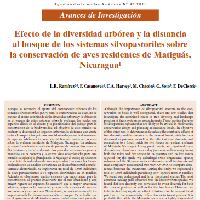Resumen
- Although the importance of silvopastoral systems to the conservation of birds is well recognized, there are few studies that investigate the combined effect of tree diversity and landscape position of these systems on avian diversity. These are two features of silvopastoral systems that are likely to be critical in biodiversity conservation design and planning at landscape levels. The objective of this study was to determine and evaluate the combined effects of tree diversity and the distance to the nearest forest patch for trees dispersed in pastures, as well as the effect of tree diversity, and connection to a forest patch for live fences on resident avifauna of Matiguás, Nicaragua. Using point counts, we registered avian diversity and abundance twice a day (morning and evening) during both the rainy and dry season in 24 pastures and 24 live fences selected for the study. We calculated avian abundance, species richness and the Shannon index of diversity in all treatments and used completely randomized two-way ANOVA to compare differences between the treatments. During the study, we registered a total of 3,506 individuals pertaining to 94 species from 28 families. We found one endangered and three threatened species. The most common feeding guild observed was the insectivorous species. We found that tree diversity was correlated to avian diversity for both the trees in pastures as well as for the live fences. However, we failed to find any significant effect of distance to the nearest forest patch or to the connectivity of live fences to forest patches. It is probable that while the Matiguás landscape is highly fragmented, it remains sufficiently connected to eliminate the effect of distance.
- Aunque se reconoce el aporte del componente arbóreo de los sistemas silvopastoriles (SSP) para la conservación de aves, no se conoce el efecto combinado de la diversidad arbórea y la ubicación en el paisaje de estos sistemas sobre la avifauna, los cuales son aspectos claves en el diseño y la planificación del paisaje para la conservación de la biodiversidad. El objetivo de este estudio fue evaluar la diversidad de especies arbóreas, la distancia que existe entre el bosque y los potreros con árboles dispersos, la dominancia de especies arbóreas y la conexión del bosque con las cercas vivas sobre la avifauna residente de Matiguás, Nicaragua. La avifuana se registró mediante el método de puntos de conteo, dos veces al día (mañana y tarde) y durante dos periodos estacionales (seco y húmedo), en 24 potreros y 24 cercas vivas seleccionadas para este estudio. Se calculó la abundancia, la riqueza y el índice de Shannon con el total de individuos de aves registrados. Las variables fueron evaluadas con un análisis de varianza en diseño bifactorial completamente aleatorizado. Se registraron un total de 3.506 individuos de aves pertenecientes a 94 especies distribuidas en 28 familias. Además, se observaron cuatro especies con importancia para la conservación. El gremio insectívoro fue el más abundante y con mayor riqueza de especies. Se encontró que a mayor diversidad arbórea, mayor es la diversidad y riqueza de especies de aves en los potreros y cercas vivas. No obstante, no encontramos efectos importantes de la distancia o conexión al bosque. Es probable que en el agropaisaje de Matiguás la conectividad estructural presente influyera a que el factor distancia no fuera muy importante.
